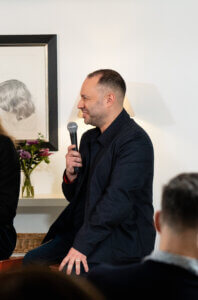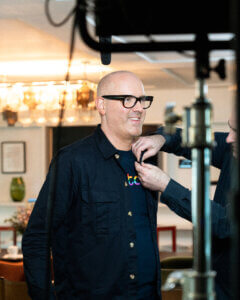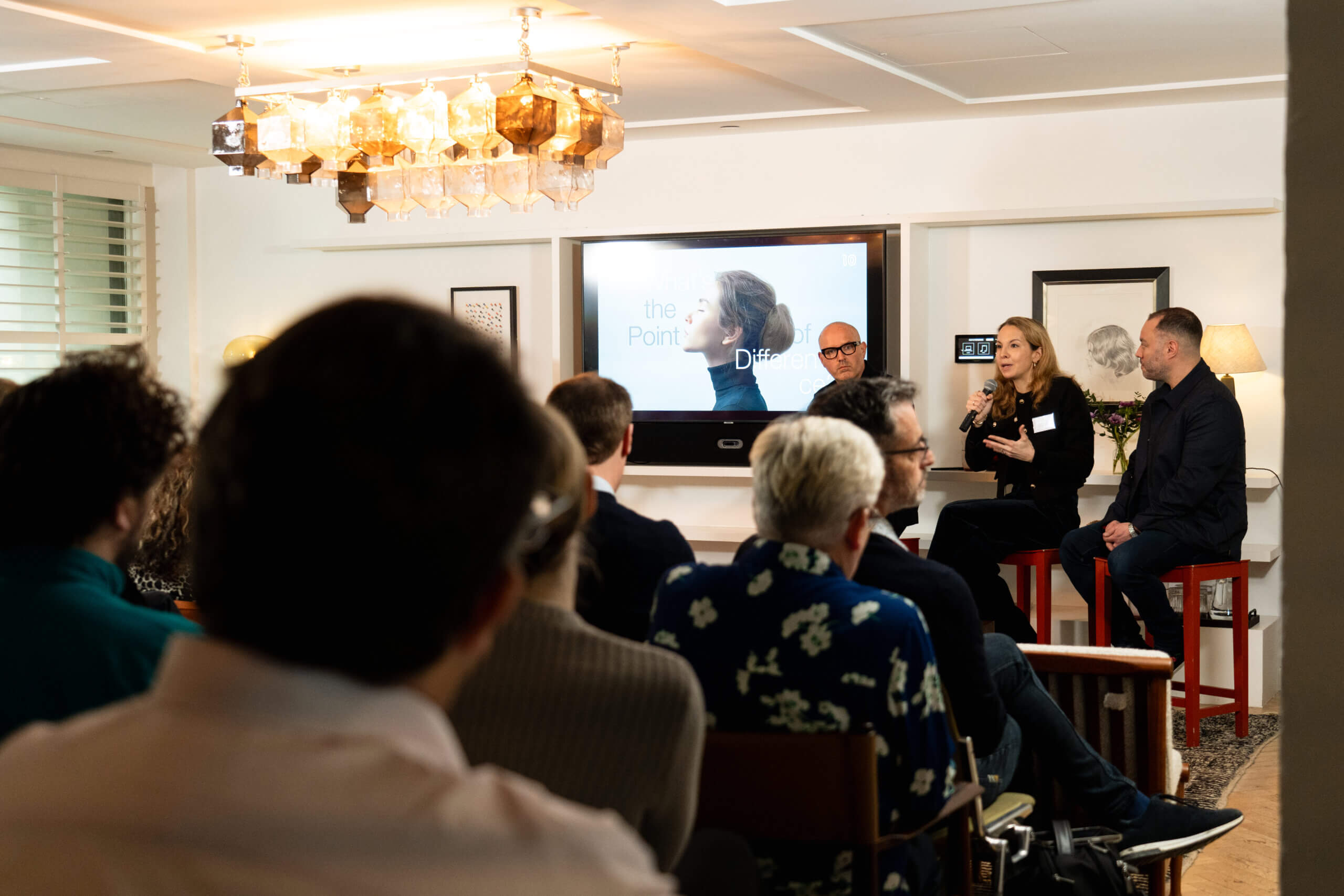Insight from the latest 10 Talks session on finding your unique point of difference in a crowded world
How many brand messages passed you by this morning? And did any stick? In this crowded world, where 328.77 million terabytes of data are created globally every day, it is not easy to be seen or heard. Being a modern brand is getting harder, and it is increasingly important to discover what makes you stand out from the rest.
That’s the point of difference.
For a brand like Apple, it’s function and design; for music streaming service Spotify, it was a new disruptive subscription model; for RM Williams boots, it’s rich heritage and product longevity. In fact, take a moment now to think about your brand’s point of difference, then read on to consider how some of the fascinating insight from the recent 10 Talks session, held in London by The 10 Group, could help you spread your message.
The importance of a point of difference was clearly underlined by the event’s moderator Katie Prescott, the Times Technology Business Editor, who revealed that her inbox receives between 1,000 and 1,500 emails every day. Yes, every day.
No human can get through that. “Most of the time, I think my inbox is unusable,” she said. “The sort of things that cut through to me are not the pitches about how Company X is implementing its AI strategy. That is not interesting, I get that all the time. Personal relationships count a lot and a really good story that helps inform the reader about the broader picture or the broader context of something is very compelling to me.”
In an in-box, you have around two seconds to make your mark. On social media, perhaps up to six. It’s not long. So how do you do it?
Target your audience and talk to them in the right way
The media and marketing landscape is changing at pace. A lot has happened since the global pandemic, and things have never been more challenging for brands to get noticed. TikTok, X, LinkedIn, traditional media, there is a glut of platforms and right now everyone is trying to shout about themselves louder than ever.
“It would be foolish to say it is not harder,” opened James Myers, Chief Commercial Officer of The 10 Group. “It feels like in 2024, the world is where it was in 2019. Everyone wants to be everywhere. It’s more crowded than it’s ever been. Plus, we have more social platforms, more influencers and more truth seekers than ever.”
The segregation of channels means access to the audience is spread increasingly thinly, so the customer is harder to find. That makes targeting even more vital and Myers cites 10 client IWC, the luxury watch brand, as a good example of how to do it. “They’re constantly thinking about how their audience is evolving,” he continued. “We’re doing something different, daily almost, to talk to younger audiences while also serving loyal customers.”
Once you have found the audience, it is equally vital to tailor the message. That is something that Izzy Woolgar, Director of External Affairs at Octopus Energy’s Centre for Net Zero gives the highest priority. “A lot of our work focuses on demand response and there are loads of different benefits you could communicate about that,” she explained. “You need to pick the right one. If I’m going to a meeting with a minister, for example, they care about a story they can sell into number 10 to attract voters, so I talk about energy bills.”
Myers concluded: “Just blasting a message, loud and brash, to consumers isn’t going to get any differentiation anymore. It’s really about thinking who you want to talk to, why you want to talk to them, and what are the methods you can use to reach that audience.”

Solve a problem and the customer will come
It may seem obvious, but if you are not solving a customer problem, you don’t have a point of difference. That can be in the product, the service, or the sell, but it needs to focus on the customer. Aira, which has worked with The 10 Group for over a year, is a great example. Its innovative subscription model has been described as ‘the Spotify of heat pumps’ by the Guardian. Cut-through. Likewise, rSIM has been hailed as ‘the next big thing’ for its unique network-switching solution. Cut-through.
Tom Guy, MD of product innovator Etc. at BT Group, is currently working with 10 Group on promoting a start-up with a clear and simple customer focus: the ability to charge EVs in the street. His team are undertaking a pilot scheme to turn the old green phone exchange cubicles into EV chargers and says is “seems to be one of the most obvious” examples of a consumer solution. Sure enough, when it was announced at CES last year, it achieved major coverage. Cut-through.
“We were taken aback by the level of cut-through this story got,” said Myers. “It literally set the news agenda through the power of that story. Tom was on BBC ‘Wake Up To Money’ first thing on the Monday morning and the momentum built from that first interview was huge. When you’re answering a problem and you’re really confident that the story cannot be cut apart by anyone that’s questioning it, it can be really powerful.”
Use your assets wisely, and learn how to evolve them
Making existing assets work hard plays a crucial part in achieving a point of difference, and as technologies evolve there is huge value to be had in asset innovation. Guy made the most of this as a founder of Centrica-backed Hive thermostats and explained: “Part of it is utilising the mothership. With Hive, it was the 12,000 British Gas engineers going into people’s homes every day that made us number one, even though Google was our competitor.”
The growth of AI is pushing asset innovation to another level and Octopus has developed its Kraken platform to use the data it collects as an asset to create wider societal value. Woolgar explained: “A lot of people were coming to Octopus and saying ‘hey, you’ve got loads of early adopters, people using EVs, heat pumps, smart tariffs, that information could be really valuable to policymakers, grid operators and so on.
“We’re working on a generative AI model trained on real world Octopus Energy customer data that outputs synthetic data, which makes it an ideal proxy for that original data set. It’s used lots in healthcare and finance, not really in energy at the moment, so it’s a really exciting way of sharing our data with loads of other people. It is a great example of a company thinking beyond profit, and that is important in terms of getting cut through.”
Guy says his team is also exploring AI and how it can “enhance everyone’s job” to improve customer interaction. But from a human perspective, he says a more diverse workforce can also create a point of difference. “You want different types of people, different thinking,” he said. “The first point that attracts people is that culture. We are trying to do it like a start-up, so it’s very fast, crazy at times, but there’s something very exciting at the end of it.”
Be bold to be different
Nobody notices the shy guy in the corner at a networking event, and the same goes for a brand trying to deliver a point of difference in this busy market. To make an impact, you need to be bold. “You need to define what is the problem to solve, from a customer or macroeconomic point, and then absolutely go after it with all intent, with everyone who works for you going after that one thing,” says Guy.
Octopus Energy is a case in point. It has disrupted quickly within a traditionally slow-paced industry and Woolgar says it was down to a bold decision to take a big picture perspective. “Octopus looked at the macroeconomic factors at play, from digitalisation to climate change, and thought ‘what do people really care about?’,” she said. “We know that 80 percent of consumers care deeply about climate change, but they just don’t quite know how to address that, so delivering a really powerful consumer proposition is key.”
That bold approach has made Octopus one of the leaders of the energy transition, helping customers optimise the way they use energy for the benefit of themselves and the network. In fact, Guy noted that when his team was developing Hive, they were thinking along the same lines but did not take the plunge. “The difference,” he explained, “is Centrica were more worried about what they might lose than what they might gain.”

Tell stories and create magic that connects the consumer
Customers do not think of differentiation, they just experience it. They align with brands because they have a connection, and that connection is usually created, quite simply, by a good – and, crucially, relevant story. “It’s about what’s important to them,” said Guy. “Customers are a bit bored because there is so much rubbish out there, so real stories that touch people are always going to be far more powerful.
“As a designer, you’re trying to change someone’s life. The first time they interact with something or hear a message, they are taken on a journey, you’re trying to create a magic moment in their lives; genuine things that make a difference. Apple is a good example. App stores were around for 10-15 years and all Apple did was create something where the customer could search, find, download, use and pay effortlessly, before anyone else. That’s what the customer’s after. Something that makes their lives better.”
Woolgar spoke of Octopus co-founder Pete Miller’s principle of the three Fs: using the fame of people outside your organisation to champion products; building a fluent brand that people easily recognise; and creating a feeling. “Consumers experience brands a bit like a piece of string,” she explained. “There’s a beginning, a middle and an end and it’s what they’re left with at the end of that experience that really counts.
“Octopus recently ran ‘saving sessions’ asking people to turn down their energy use during peak periods and paying them to do that. At the end, you would get an email that said ‘hey, well done, you saved £7.23 on your energy bills – do you want to bank that or do you want us to match fund it for a charity of your choice?’ It’s small things like that that really make the difference.”
Guy has seen the role of marketing and comms become more integrated with the entire product development process during his career and added: “In the first few start-ups, I would push marketing away. Now, they’re in the heart of the creation process, because then they can tell that story better. It’s far more human and real. The best bits come out whilst you’re on the whiteboard with the developer and the designer and that’s something we’ve done with 10 Group a lot, where they’re right at the heart of that.”
At the Times, Prescott spends a lot of time and effort personalising complicated tech stories for her audience. Typically, her readers are interested in technology but do not necessarily understand it. The importance of simplification, for tech and, in fact, for any industry, can never be understated. Quite simply, she explained, “If the general public doesn’t understand it, your story’s not going to go anywhere.”
The 10 Group works hard to extract stories from places clients had not thought of, and Myers concluded: “In a business, you’re stuck in it every day and external creatives, external strategists, can really help bring that story to life. There is a story in every brand, a story from every person, so it’s about digging deep. We believe in getting into an organisation, understanding what makes it tick and its customers tick, and trying to marry that together. Everyone has a story to tell. That sounds really cliché, but it’s true.”
Thank you to participants Tom Guy, MD, Etc. at BT Group; Izzy Woolgar, Director of External Affairs, Centre for Net Zero (launched by Octopus Energy); James Myers, Chief Commercial Officer, The 10 Group; and moderator Katie Prescott, Tech Editor, The Times.
